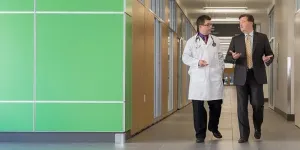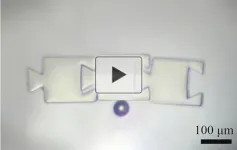Target of new cancer treatment valid for breast as well as blood cancers: study
Results reinforce rationale for clinical trials expected to begin in May
2021-01-21
(Press-News.org) One more piece of the puzzle has fallen into place behind a new drug whose anti-cancer potential was developed at the University of Alberta and is set to begin human trials this year, thanks to newly published research.
"The results provide more justification and rationale for starting the clinical trial in May," said first author John Mackey, professor and director of oncology clinical trials in the Faculty of Medicine & Dentistry. "It's another exciting stepping stone to finding out if this is going to be a new cancer treatment."
The drug PCLX-001 is designed to selectively kill cancer cells by targeting enzymes involved in myristoylation, a process key to the cell signalling system that is often defective in cancer cells. The molecule was originally developed by the University of Dundee as a treatment for African sleeping sickness. U of A cell biologist Luc Berthiaume was the first to realize it could work against cancer.
For this study, Mackey and his collaborators examined breast tumours from more than 700 women who had participated in a worldwide clinical trial for another drug in 1998. They found that 28 per cent of the tumours contained the enzyme N-myristoyltransferase 2 (NMT2), and that the patients who had those tumours were more likely to die during the following 10 years.
"This shows that one of the targets of our drug, the enzyme NMT2, is clinically important to overall survival," said Mackey, who is also co-founder and chief medical officer of Pacylex Pharmaceuticals, the U of A spinoff company set up to develop PCLX-001.
The researchers also reported that breast cancer cells treated with PCLX-001 in the laboratory were less viable, and that the drug slowed tumour growth by 90 per cent in mice with human breast cancer. These results are similar to those reported last fall on PCLX-001's effect against lymphoma, a blood cancer which affects the infection-fighting cells of the immune system.
The clinical trial will take place in three Canadian centres, including the Cross Cancer Institute in Edmonton, and will enrol patients with advanced and previously treated lymphoma, breast, lung, colon or bladder cancers. The aim is to find the optimal dose of PCLX-001 for effectiveness and safety.
"This will be the first time anyone has ever received PCLX-001 or a drug of this class," Mackey noted. "It's very exciting, but there are many unknowns."
The study was funded by the Alberta Cancer Foundation and the Cure Cancer Foundation.
"We've had tremendous support from the local investor and donor communities for our made-in-Alberta innovation," Mackey said.
INFORMATION:
[Attachments] See images for this press release:

ELSE PRESS RELEASES FROM THIS DATE:
2021-01-21
Better grades thanks to your fellow students? A study conducted by the University of Zurich's Faculty of Business, Economics and Informatics has revealed that not only the grade point average, gender and nationality peers can influence your own academic achievement, but so can their personalities. Intensive contact and interaction with persistent fellow students improve your own performance, and this effect even endures in subsequent semesters.
Personality traits influence many significant outcomes in life, such as one's educational attainment, income, career achievements or health. Assistant Professor Ulf Zölitz of the University of Zurich's Department of Economics and Jacobs Center for Productive Youth Development has investigated how one's own personality affects fellow students.
The ...
2021-01-21
Robots are widely used to build cars, paint airplanes and sew clothing in factories, but the assembly of microscopic components, such as those for biomedical applications, has not yet been automated. Lasers could be the solution. Now, researchers reporting in ACS Applied Materials & Interfaces have used lasers to create miniature robots from bubbles that lift, drop and manipulate small pieces into interconnected structures. Watch a video of the bubble microrobots in action here.
As manufacturing has miniaturized, objects are now being constructed that are only a few hundred micrometers long, or about the thickness of a sheet of paper. But it is hard to position ...
2021-01-21
HOUSTON - (Jan. 20, 2021) - Once upon a time, seasons in Gale Crater probably felt something like those in Iceland. But nobody was there to bundle up more than 3 billion years ago.
The ancient Martian crater is the focus of a study by Rice University scientists comparing data from the Curiosity rover to places on Earth where similar geologic formations have experienced weathering in different climates.
Iceland's basaltic terrain and cool weather, with temperatures typically less than 38 degrees Fahrenheit, turned out to be the closest analog to ancient Mars. The study determined that temperature had the biggest impact on how rocks formed from sediment ...
2021-01-21
Since SARS-CoV-2 was identified in December 2019, researchers have worked feverishly to study the novel coronavirus. Although much knowledge has been gained, scientists still have a lot to learn about how SARS-CoV-2 interacts with the human body, and how the immune system fights it. Now, researchers reporting in ACS Pharmacology & Translational Science have developed a mathematical model of SARS-CoV-2 infection that reveals a key role for the innate immune system in controlling viral load.
The COVID-19 pandemic has created tremendous socioeconomic problems and caused the death of almost 2 million people worldwide. Although vaccines ...
2021-01-21
Scientists at the University of Bonn have built hair-thin optical fibre filters in a very simple way. They are not only extremely compact and stable, but also colour-tunable. This means they can be used in quantum technology and as sensors for temperature or for detecting atmospheric gases. The results have been published in the journal Optics Express.
Optical fibers not much thicker than a human hair today not only constitute the backbone of our world-wide information exchange. They are also the basis for building extremely compact and robust sensors with very high sensitivity for temperature, chemical analysis and much more.
Optical resonators or filters are important components cutting out very narrow spectral lines from white light sources. In the simplest case such filters ...
2021-01-21
Tityus serrulatus, the Yellow scorpion, causes more deaths than any other venomous animal in Brazil. Its sting can induce heart attack and pulmonary edema, especially in children and the elderly. According to the Brazilian Health Ministry, more than 156,000 cases of scorpion envenomation, 169 fatal, were reported in the country in 2019.
Researchers at the University of São Paulo (USP) have demonstrated for the first time that in severe cases of scorpion envenomation a systemic neuroimmune reaction produces inflammatory mediators leading to the release of neurotransmitters. A paper reporting the results of their study is published
in Nature Communications. It suggests the inflammatory process can be inhibited by administration of a corticosteroid almost immediately after the ...
2021-01-21
Skoltech researchers and their collaborators from France, the US, Switzerland, and Australia were able to create and describe a mixed oxide Na(Li1/3Mn2/3)O2 that holds promise as a cathode material for sodium-ion batteries, which can take one day complement or even replace lithium-ion batteries. The paper was published in the journal Nature Materials.
Lithium-ion batteries are powering the modern world of consumer devices and driving a revolution in electric transportation. But since lithium is rather rare and challenging to extract from an environmental standpoint, researchers and engineers have been looking for more sustainable and cost-effective alternatives for quite some time now.
One option is sodium-ion technology, as sodium is much more abundant than ...
2021-01-21
Researchers Yulia Chilipenok, Olga Gaponova, Nadezhda Gaponova and Lyubov Danilova of HSE - Nizhny Novgorod looked at how the lockdown has impacted Russian women during the COVID-19 pandemic. They studied the following questions: how women divided their time; how they worked from home; how they got on with their partners and children; and how they dropped old habits and started new ones in relation to nutrition, health, beauty, and self-development. In cases in which the whole family had to stay home together for a long time, it was largely women on whom the family's adaptation to the new reality depended. The paper was published in the Woman in Russian Society Journal.
It is difficult to find a strictly academic definition for today's 'self-isolation'. According to the ...
2021-01-21
A new study from researchers at the Allen Institute collected and analyzed the largest single dataset of neurons' electrical activity to glean principles of how we perceive the visual world around us. The study, published Wednesday in the journal Nature, captures the hundreds of split-second electrical signals that fire when an animal is interpreting what it sees.
Your brain processes the world around you nearly instantaneously, but there are numerous lightning-fast steps between light hitting your retinas and the point at which you become aware of what's in front of you. Humans have three dozen different brain areas responsible for understanding the visual world, and scientists still don't ...
2021-01-21
Various software packages can be used to evaluate products and predict failure; however, these packages are extremely computationally intensive and take a significant amount of time to produce a solution. Quicker solutions mean less accurate results.
To combat this issue, a team of Penn State researchers studied the use of machine learning and image colorization algorithms to ease computational load, maintain accuracy, reduce time and predict strain fields for porous materials. They published their work in the Journal of Computational Materials Science with accompanying presentations and proceedings in Procedia Engineering.
"There is always a human side to design," said Chris McComb, assistant professor of engineering design in the School of Engineering Design, ...
LAST 30 PRESS RELEASES:
[Press-News.org] Target of new cancer treatment valid for breast as well as blood cancers: study
Results reinforce rationale for clinical trials expected to begin in May







